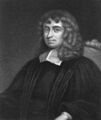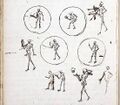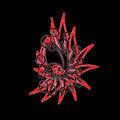Template:Selected anniversaries/May 4: Difference between revisions
No edit summary |
No edit summary |
||
| Line 7: | Line 7: | ||
||1655: Bartolomeo Cristofori born ... instrument maker, invented the piano. Pic. | ||1655: Bartolomeo Cristofori born ... instrument maker, invented the piano. Pic. | ||
||1675: King Charles II of England orders the construction of the Royal Greenwich Observatory. | ||1675: King Charles II of England orders the construction of the Royal Greenwich Observatory. Pic. | ||
File:Isaac Barrow.jpg|link=Isaac Barrow (nonfiction)|1677: Mathematician and theologian [[Isaac Barrow (nonfiction)|Isaac Barrow]] dies. He played an early role in the development of infinitesimal calculus. | File:Isaac Barrow.jpg|link=Isaac Barrow (nonfiction)|1677: Mathematician and theologian [[Isaac Barrow (nonfiction)|Isaac Barrow]] dies. He played an early role in the development of infinitesimal calculus. | ||
| Line 13: | Line 13: | ||
File:Huygens sketches of Death.jpg|1680: Steganographic analysis of sketches by [[Christiaan Huygens (nonfiction)|Huygens]] for a projection of Death taking off his head, an early example of [[Phantasmagoria (nonfiction)|Phantasmagoria]], reveals "several hundred uinits" of unencrypted data. (The archaic term "uinit" is thought to roughly correspond with a kilobyte.) | File:Huygens sketches of Death.jpg|1680: Steganographic analysis of sketches by [[Christiaan Huygens (nonfiction)|Huygens]] for a projection of Death taking off his head, an early example of [[Phantasmagoria (nonfiction)|Phantasmagoria]], reveals "several hundred uinits" of unencrypted data. (The archaic term "uinit" is thought to roughly correspond with a kilobyte.) | ||
||1726: | ||1726: William Roy born ... Scottish military engineer, surveyor, and antiquarian. He was an innovator who applied new scientific discoveries and newly emerging technologies to the accurate geodetic mapping of Great Britain. Pic: map, plaque. | ||
File:Jean Charles Borda.jpg|link=Jean-Charles de Borda (nonfiction)|1733: Mathematician, physicist, and sailor [[Jean-Charles de Borda (nonfiction)|Jean-Charles de Borda]] born. He will contribute to the development of the metric system, constructing a platinum standard meter, the basis of metric distance measurement. | File:Jean Charles Borda.jpg|link=Jean-Charles de Borda (nonfiction)|1733: Mathematician, physicist, and sailor [[Jean-Charles de Borda (nonfiction)|Jean-Charles de Borda]] born. He will contribute to the development of the metric system, constructing a platinum standard meter, the basis of metric distance measurement. | ||
| Line 61: | Line 61: | ||
||1972: Edward Calvin Kendall dies ... chemist and academic, Nobel Prize laureate. | ||1972: Edward Calvin Kendall dies ... chemist and academic, Nobel Prize laureate. | ||
||1974: William Maurice "Doc" Ewing dies ... geophysicist and oceanographer. | ||1974: William Maurice "Doc" Ewing dies ... geophysicist and oceanographer. Pic. | ||
||1922: Alexander Randolph born ... designer of board games and writer. Randolph's game creations include TwixT, Breakthru, Inkognito (with Leo Colovini), Raj, Ricochet Robot, and Enchanted Forest (with Michael Matschoss). | ||1922: Alexander Randolph born ... designer of board games and writer. Randolph's game creations include TwixT, Breakthru, Inkognito (with Leo Colovini), Raj, Ricochet Robot, and Enchanted Forest (with Michael Matschoss). | ||
Revision as of 19:25, 29 March 2019
1677: Mathematician and theologian Isaac Barrow dies. He played an early role in the development of infinitesimal calculus.
1680: Steganographic analysis of sketches by Huygens for a projection of Death taking off his head, an early example of Phantasmagoria, reveals "several hundred uinits" of unencrypted data. (The archaic term "uinit" is thought to roughly correspond with a kilobyte.)
1733: Mathematician, physicist, and sailor Jean-Charles de Borda born. He will contribute to the development of the metric system, constructing a platinum standard meter, the basis of metric distance measurement.
1825: Biologist Thomas Henry Huxley born. He will be known as "Darwin's Bulldog" for his advocacy of Charles Darwin's theory of evolution.
1839: Mathematician, art critic, and alleged time-traveller The Eel teams up with mathematician and criminologist Joseph Diez Gergonne. Working together, they will develop a new theory of projective geometry which detects and prevents shape theft and several other types of crimes against mathematical constants.
1859: Mathematician and logician Joseph Diez Gergonne dies. He contributed to the principle of duality in projective geometry, by noticing that every theorem in the plane connecting points and lines corresponds to another theorem in which points and lines are interchanged, provided that the theorem embodied no metrical notions.
1860: USS Cairo retrofitted with military Gnomon algorithm functions for use in fighting crimes against mathematical constants.
1921: Physicist Harry Daghlian born. He will be fatally irradiated in a criticality accident during an experiment with the Demon core at Los Alamos National Laboratory.
1943: Alice Beta Paragliding published. Many experts believe that the illustration depicts Beta infiltrating the ENIAC program, although this is widely debated.
2018: Signed first edition of Fire Dance spontaneously bursts into flames during steganographic analysis. Despite extensive damage from fire and smoke, almost all of the data from the image will be recovered.









